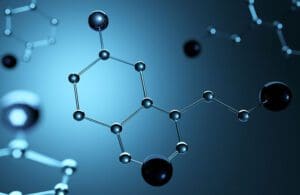
Serotonin molecule [Vladimir/Adobe Stock]
Neuropsychiatric disorders, such as depression and anxiety, are among the leading causes of disability worldwide. Almost one billion people globally — roughly one out of eight individuals — live with a mental disorder, with anxiety and depressive disorders the most common, according to the World Health Organization. Yet current therapies such as selective serotonin reuptake inhibitors (SSRIs) offer limited efficacy and come with undesirable side effects. Additionally, they may take weeks to produce noticeable benefits.
These challenges have sparked interest in alternative treatments, including psychedelics and psychoplastogens, for mental health treatment, as noted by Dr. Kurt Rasmussen, Delix‘s chief scientific officer. “There are now a lot of researchers looking at psychoplastogens as a way to help remodel those circuits and treat depression and anxiety more rapidly and enduringly than the current treatments,” he said.
Coined around 2018, the term “psychoplastogens” represent a class of molecules that promote neuroplasticity, or the ability of the brain to adapt and rewire itself by forming new neural connections, making it a vital component of the healing process for neuropsychiatric disorders. While psychoplastogens encompass classic psychedelics, ketamine and other novel rapid-acting antidepressants, not all of them cause hallucinations. Their key characteristic is the ability to enhance neuroplasticity, particularly in the prefrontal cortex, which can be beneficial for treating neuropsychiatric disorders.
One factor driving the psychoplastogen and psychedelic research surge is the observation that mood disorders are linked to reduced activity in the prefrontal cortex (PFC), particularly the dorsolateral prefrontal cortex (DLPFC), which is associated with cognitive control and emotional regulation. This reduced activity is associated with functional neuronal changes in this region. Yet treatments such as transcranial magnetic stimulation and ketamine, can reverse these circuit abnormalities, as a 2020 Nature article noted.
On ketamine’s impact and the drawbacks of classic psychedelics
The breakthrough discovery of ketamine’s rapid antidepressant effects has been particularly influential in the field. The number of ketamine infusion clinics in the U.S. has exploded over the past decade, offering the dissociative anesthetic as an off-label treatment for mood disorders. In 2019, FDA approved a ketamine stereoisomer (esketamine) known as Spravato.

Kurt Rasmussen
In contrast to traditional antidepressants, ketamine can have an almost immediate therapeutic effect. Rasmussen explained: “Ketamine has a very rapid onset, and it really changed everything.”
Ketamine, however, comes with its challenges. “The problem with ketamine is it’s also a drug of abuse, and it’s also a dissociative anesthetic,” Rasmussen noted.
Classic psychedelics are similar in offering both promise and pitfalls for patients with mood disorders. “One of the issues with psychedelics is that they can cause hallucinations, and they can cause psychotic episodes,” Rasmussen said. That fact makes them potentially ill-suited for patients with a familial background of psychosis or schizophrenia, for example.
Scale challenges for novel therapies
Furthermore, it may be difficult to use psychedelics at scale therapeutically given the likelihood that regulators will constrain their use to clinical settings. “We’re talking about administering psychedelics in a very controlled environment, typically with a therapist present,” Rasmussen said. Given that many psychedelics have a duration of action lasting multiple hours, which could translate into considerable staffing and overhead expense. “It’s not really scalable for the number of people that need treatment,” Rasmussen added.
Given that classic psychedelics haven’t been widely studied in decades until recently, questions remain about their benefit-risk ratio. Part of the drugs’ mood-lifting potential is associated with the 5-HT2A receptor, a serotonin receptor subtype. Serotonin and structural analogs of serotonin, including psychedelics, activate that receptor. “One of the problems with the classic psychedelics, however, is that they also have activity at the 5-HT2B receptor, and that receptor is associated with valvulopathy or heart valve damage,” Rasmussen said. Regulators have expressed concern about this aspect, Rasmussen noted.
This underscores the importance of developing novel compounds that can avoid targeting the 5-HT2B receptor and mitigate the potential risks associated with classic psychedelics, while still offering the therapeutic benefits needed for treating neuropsychiatric disorders.
From psychedelics to non-hallucinatory psychoplastogens
Non-hallucinatory psychoplastogens have gained attention in recent years as potential alternatives to psychedelics for treating mental health disorders.
The U.S. military is backing research into the compounds. In 2020, the Defense Advanced Research Project Agency (DARPA) awarded a four-year $27 million cooperative agreement to researchers at the University of North Carolina School of Medicine, led by professor Dr. Bryan L. Roth. The researchers there are using novel structural biology and computational approaches to identify novel rapid-acting psychedelic-inspired medicines that avoid the adverse effects that can sometimes accompany classic psychedelics.
Rasmussen highlights that “there are a lot of people who are interested in the concept of a non-hallucinatory psychoplastogen.” Numerous companies, including Boston-based Delix and Onsero Therapeutics, are working on developing novel compounds and refining their structure-activity relationship (SAR) to optimize their therapeutic effects. “It’s not just Delix, but there are multiple companies working on this problem,” Rasmussen stated.
A recent study published in Nature showcases the potential of these new molecules by exploring bespoke library docking for 5-HT2A receptor agonists with antidepressant activity. The researchers found that these new agonists demonstrated potent antidepressant activity in mouse models and had the same efficacy as traditional antidepressants, such as fluoxetine, at as low as one-fourtieth of the dose.
The future landscape of psychedelics to psychoplastogens
Rasmussen envisions a future in which healthcare providers will have multiple treatment options tailored to individual patients’ needs. Insurance and reimbursement factors will play a role in the adoption of new treatments, Rasmussen acknowledged. “I can imagine the insurance agencies will make you fail first on a cheap SSRI that costs a nickel a day,” he said. “If you don’t respond to that, then you can venture into other things.”
Continued research and development will be crucial in refining treatment paradigms and establishing best practices for the use of psychoplastogens. Rasmussen acknowledged that determining the most effective treatment strategies and understanding how to use these new medications for distinct patient populations will be a time-consuming process. “It’ll take a long time to sort that out,” he said. A new therapy that passes regulatory muster will “have to be in clinical use for a long period to really appreciate how to use them best for different patients.”
As we move closer to developing rapid and enduring treatments for neuropsychiatric disorders, Rasmussen expresses optimism, stating, “We’re one step closer to really, really treating these neuropsychiatric diseases.” With a growing spectrum of compounds being developed to address diverse patient needs, the future of mental health care may be transformed. Rasmussen remarks, “People will laugh at how we used to treat neuropsychiatric diseases,” he said. “People are going to look back at us now and say, ‘Oh, man, I’m glad I didn’t have depression back when those guys were alive.”